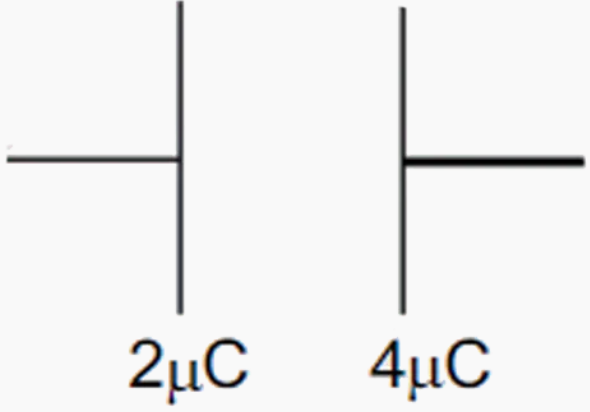A parallel plate capacitor has plates of area 200cm^2 and separation between the plates 1.00 mm. What potential difference will be developed if a charge of 1.00 nC )(i.e., 1.00X10^(-9) C) is given to the capacitor? If the plate separation is now increased to 2.00 mm, what will be the new potential difference?Solution in Tamil
The capacitance of the capacitor is <br>C=(epsilon_o A)/(d)<br> <br>= 8.85 X 10^(_12) Fm ^(-1) X (200 X10^(-4) m^2)/(1X10^(-3) m)<br> <br>= 0.177 X 10 ^(-9) F = 0.177 nF. The potential difference between the plates is <br> V =(Q)/(C ) = (1nC)/(0.177 nF) = 5.65 volts. if the separation is increased from 1.00 mm to 2.00 mm, the capacitance is decreased by a factor of 2. If the charge remains the same, the potential difference will increase by a factor of 2. Thus, the new potential difference will be <br>5.65 volts X 2 = 11.3 volts.
Topper's Solved these Questions
- CAPACITORSBook:HC VERMAChapter:CAPACITORSExercise:short answer
Explore 7 Videos
- CAPACITORSBook:HC VERMAChapter:CAPACITORSExercise:Objective 1
Explore 12 Videos
- CAPACITORSBook:HC VERMAChapter:CAPACITORSExercise:Exercise
Explore 68 Videos
- BOHR'S MODEL AND PHYSICS OF THE ATOMBook:HC VERMAChapter:BOHR'S MODEL AND PHYSICS OF THE ATOMExercise:Exercises
Explore 46 Videos
- DISPERSION AND SPECTRABook:HC VERMAChapter:DISPERSION AND SPECTRAExercise:Exercises
Explore 11 Videos
Similar Questions
Suppose a charge +Q1 is given to the positive plates and a charge −Q2 to the negative plate of a capacitor. What is the "charge on the capacitor"?
View SolutionA capacitor of capacitance C is charged to a potential V. The flux of the electric field through a closed surface enclosing the capacitor is
View SolutionWhen 1.0×1012electrons are transferred from one conductor to another, a potential difference of 10V . What will be capacitance of the two -conductor system .
View SolutionThe bohr radius is given by a0=ε0h2πme2 verify that the RHS has dimesions of length
View SolutionA flint glass prism and a crown glass prism are to be combined in such a way that the deviation of the mean ray is zero. The refractive index of flint and crown glasses for the mean ray are 1.620 and 1.518 respectively. If the refracting angle of the flint prism is 6.0∘, what would be the refracting angle of the crown prism ?
View SolutionIn a parallel plate capacitor of capacitor 1μF two plates are given charges 2μC and 4μC the potential difference between the plates of the capacitor is

View SolutionA parallel -plate capacitor having plate area 25.0cm^2 and a separation2.00mm between the plates .the capacitor is connected to a battery of 12.0V. (a) Find the charge on the capacitor. (b) the plate separation is decreased to 1.00mm. Find the extra charge given by the battery to the positive plate.
View SolutionA parallel plate capacitor is constructed with plates of area 0.0280 m^(2) and separation 0.550 mm . Find the magnitude of the charge on each plate of this capacitor when the potential between the plates is 20.1 V
View SolutionThe separation between the plates of a parallel plate capacitor is t, and the intervening space is filled with glass, of dielectric constant 6. Now, the separation between the plates is increased by t. How would the charge on the capacitor and the potential difference between its plates charge, if
The battery is disconnected before increasing the separation between the plates?
View SolutionA parallel plate capacitor having plate area A and separation between the plates d is charged to potential V .The energy stored in capacitor is ....???
View SolutionIf the separation between the plates of a capacitor is 5 mm , then area of the plate of a 3 F parallel plate capacitor is
View SolutionThe plates of a parallel plate capacitor are charged to 100V. Then a 4mm thick dielectric slab is inserted between the plates and then to obtain the original potential difference , the distance between the system plates is increased by 2.00 mm. the dielectric constant of the slab is
View SolutionA parallel plate air capacitor has capacity 'C' distance of separation between plates is 'd' and potential difference 'V' is applied between the plates force of attraction between the plates of the parallel plate air capacitor is :
View SolutionA parallel -plate capacitor having plate area 25.0cm^2 and a separation2.00mm between the plates .the capacitor is connected to a bettery of 12.0V.(a)find the charge on the capacitor .(b) the plate separation is decrerased to 1.00mm. Find the extra charge given by the bettery to the positive plate.
View SolutionIn a parallel plate capacitor of capacitor 1μF two plates are given charges 2μC and 4μC the potential difference between the plates of the capacitor is
_2019_CBT2_E01_002_Q01.png)
View SolutionA parallel plate capacitor has circular plates of radius 8 cm and plate separation 1mm. What will be the charge on the plates if a potential difference of 100V is applied?
View Solution